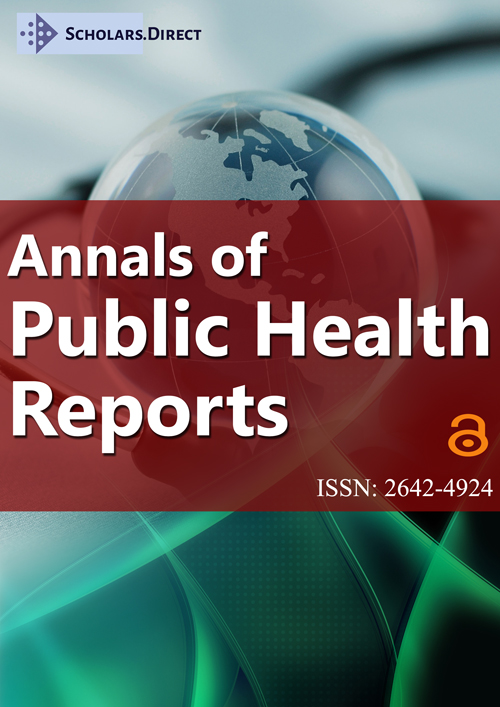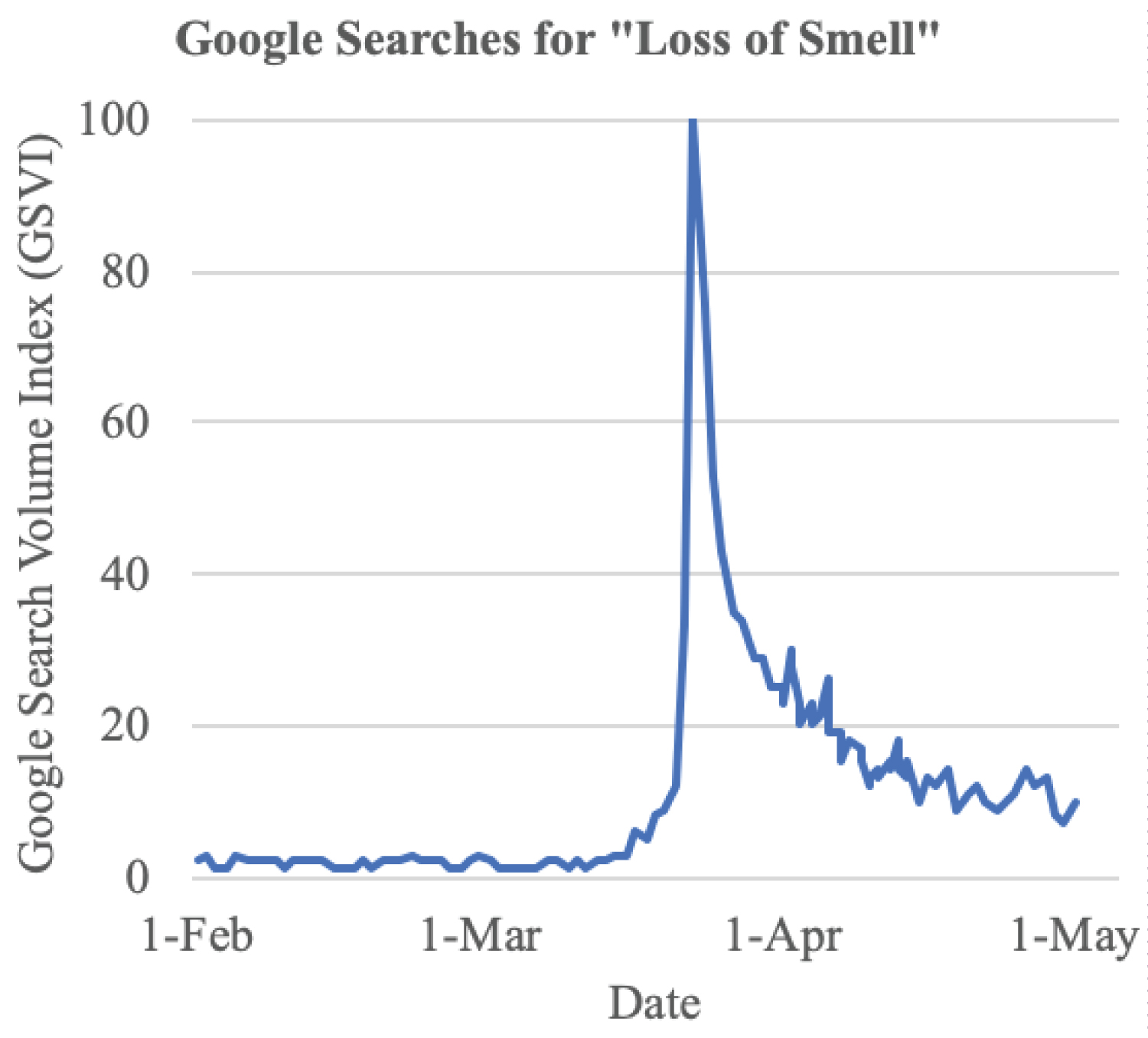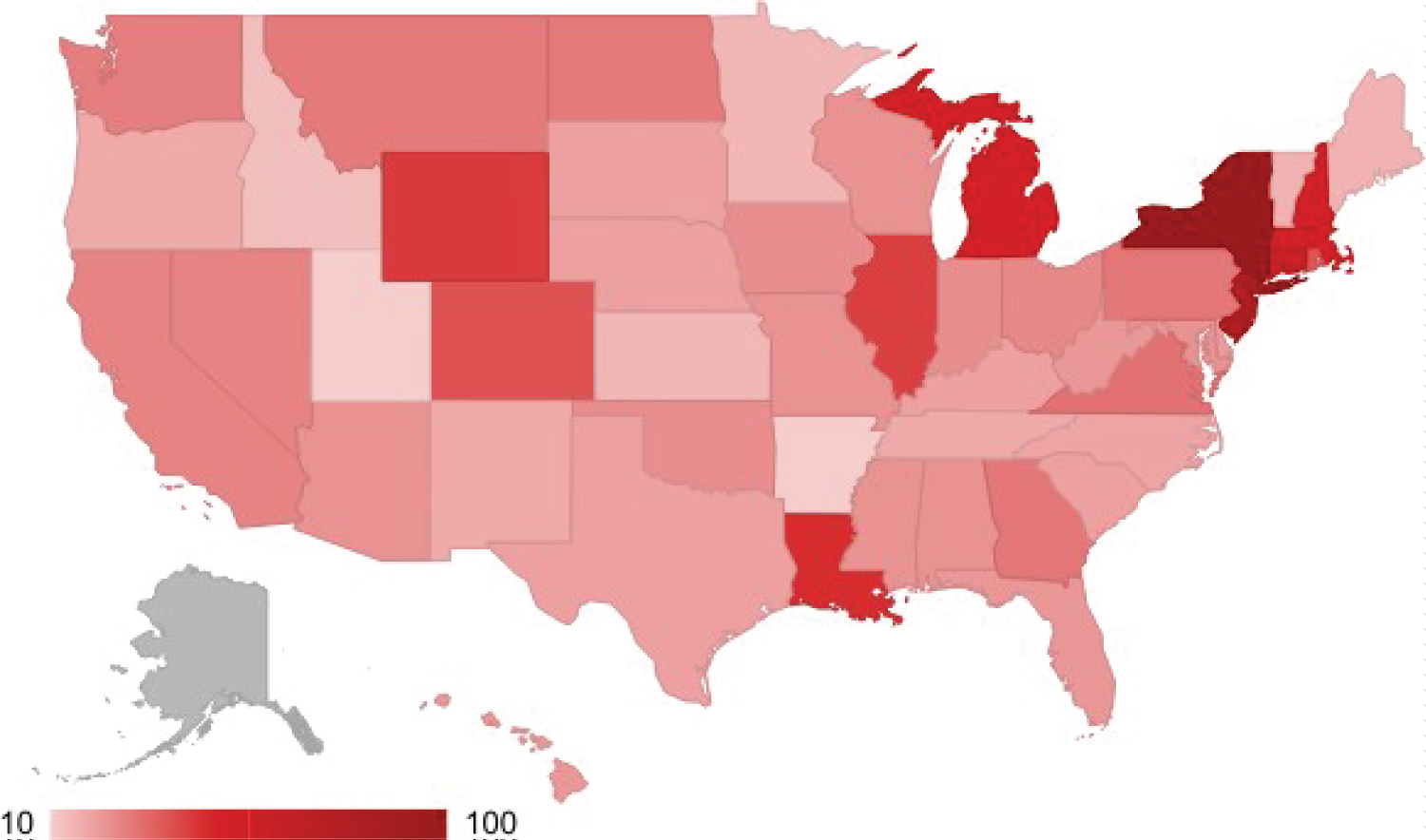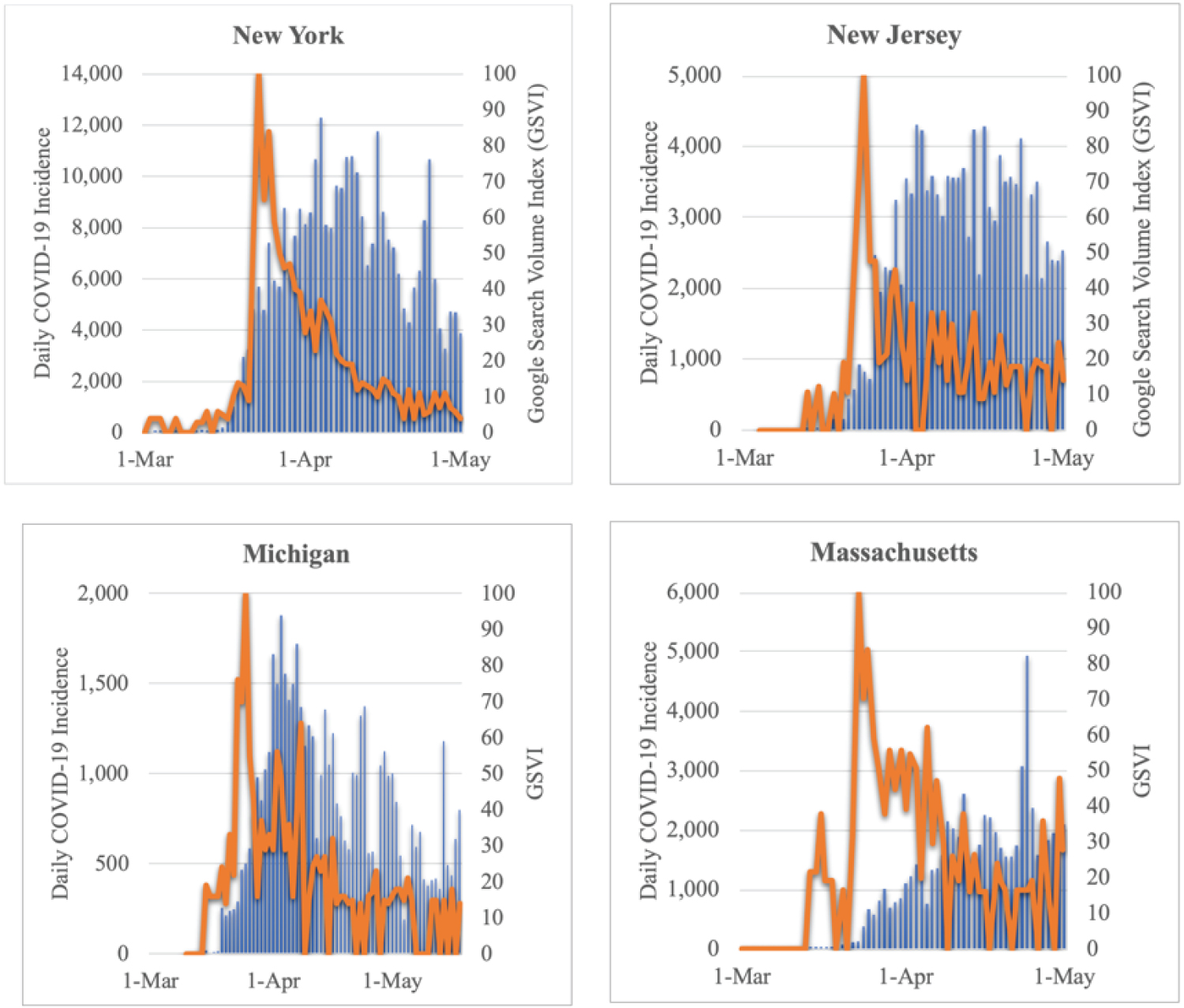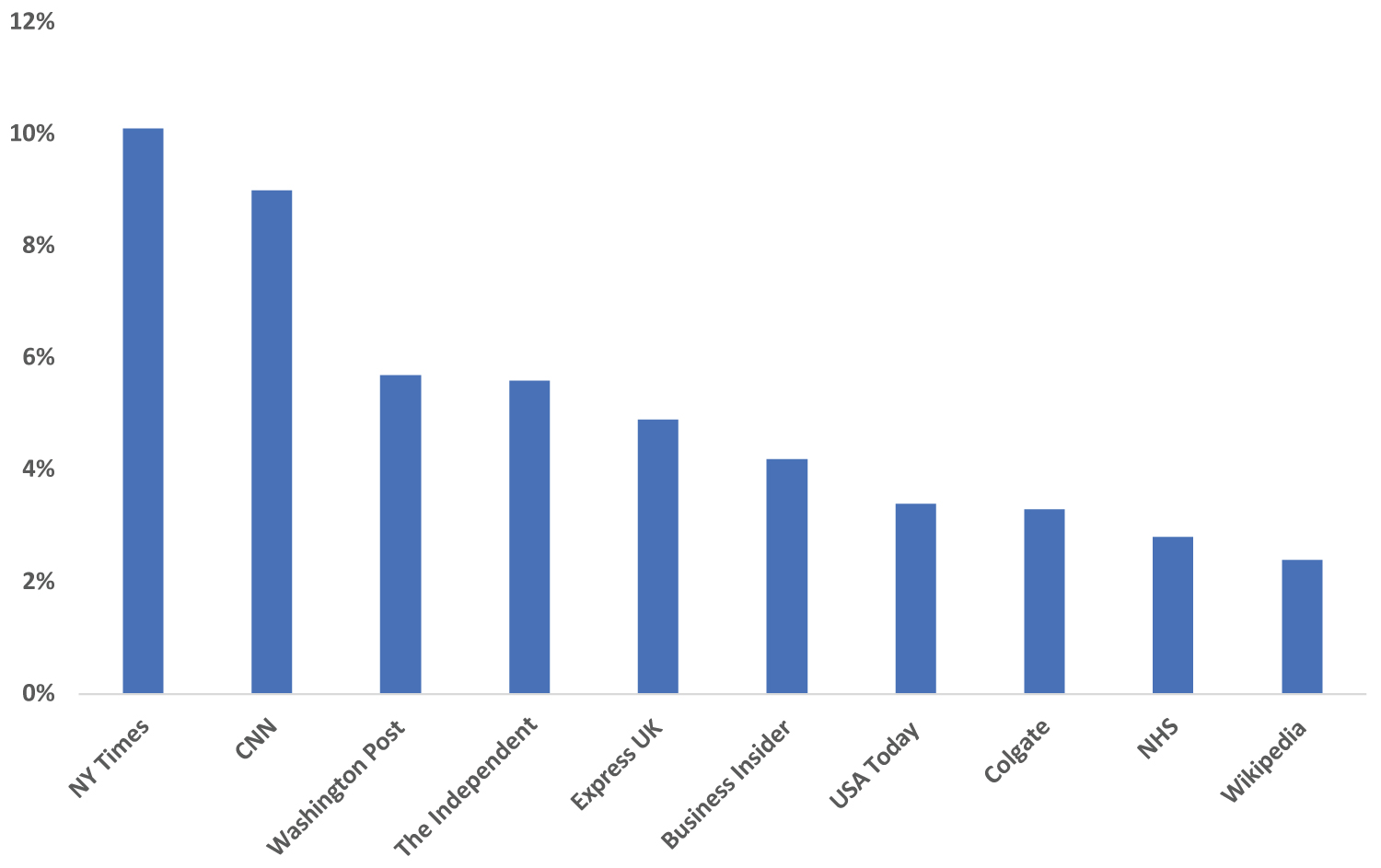Mass Media and Public Interest in COVID-19: An Investigation of Anosmia Related Search Queries in the United States
Abstract
Introduction
Coronavirus-Disease-2019 (COVID-19) can be heralded by anosmia as a major symptom in up to 60% of patients. In this study, we sought to describe the temporal and geospatial distribution of anosmia in internet search queries relative to COVID-19 case densities across the United States, and to characterize the quality of online resources people used for anosmia searches during the early stages of the pandemic.
Methods
We identified keywords to reflect searches relating to anosmia. Google Trends was used to monitor the geospatial and temporal distribution of anosmia-related search queries. Similar web technologies data were used to extract US website utilization for anosmia search queries from January to March 2020. COVID-19 positive results were determined from data reported by the CDC and health departments.
Results
As of April 17, 2020, New York, New Jersey, and Connecticut had the most anosmia-related search queries. In January and February 2020, search queries were at just 1.8% of the peak search volume on March 23, 2020. In March, searches for anosmia-related terms increased to 73,600, a 177% increase from February queries. The top websites resulting from queries in March were The New York Times (10.1%), CNN (9.0%), and The Washington Post (5.7%), with "other" websites accounting for 48.5% of searches.
Conclusion
States with high prevalence of COVID-19 showed significant increases in searches pertaining to anosmia during peak times of disease. Patients investigating their loss of smell have been routed to a variety of online resources, with significant risk of patient misinformation. The months following the onset of the pandemic are critical for the creation of accurate resources for their patients and the population as a whole.
Introduction
Coronavirus-disease-2019 (COVID-19), caused by Sars-CoV-2 strain of coronavirus has quickly spread across the world and reached global pandemic status per the World Health Organization in March 2020. As of June 30, 2020, over 10.3 million individuals globally have tested positive, with over 25% of the case density being in the United States [1]. The US has also been the country with the highest volume of COVID-related deaths, totaling near 130,000. The COVID-19 associated illness has shocked our healthcare system primarily due to its variable clinical presentation. While classically described as "flu-like symptoms" with fever, myalgias, cough, the heterogeneous presentation has been noted to progress to shortness of breath, pneumonia, GI symptoms such as diarrhea and abdominal pain, among others [2,3]. As alternative presentations manifest on a near daily basis, clinicians and scientists alike continue to investigate the relationship between viral course and symptomatology to provide the best possible care for COVID-19 patients.
Due to the high mucosal viral load, with the nasal cavity as a primary site of viral entry and replication, growing data supports the inclusion of anosmia or hyposmia as one of the presenting symptoms in COVID-19 patients [4,5]. Initial reports have suggested that anosmia could occur in the absence of some of the cardinal symptoms, and instead was a sign of early infection in some patients [6]. Notably, younger and healthier patients have presented with isolated anosmia [7]. In late March 2020, the American Academy of Otolaryngology-Head and Neck Surgery identified anosmia as a symptom of interest and coordinated with clinicians nationally to aggregate data on anosmia in COVID-19. Initial data suggest that, with 73% of patients reporting anosmia prior to COVID-19 diagnoses, anosmia can be a presenting symptom. Timely identification of changes to sense of smell may help limit disease transmission [8].
Data pertaining to anosmia as an early-onset symptom have become more mainstream. The general population is now more cognizant and paying particular attention to the primary symptoms of the COVID-19 infection. Accordingly, interest in anosmia from the general population has increased. A recent study published in early April suggests that the rise in COVID-19 cases correlated strongly with smell-related online searches in Spain, Italy, and the United Kingdom during the early stages of the pandemic [9]. This was also corroborated by recent analyses correlating COVID-19 incidence in the US with Twitter and Google search activity [10,11]. However, despite strong relationships being identified with rapid spread of infection in the United States, it remains unknown whether such an association exists at a state-by-state level. Furthermore, while searches pertaining to anosmia have surged, it is unclear where potential COVID-19 patients are being routed for information gathering.
Google Trends has been used in a variety of fields, such as skin cancer, influenza, and COVID-19, to analyze search queries at a population-level [9,12,13]. The analysis provides data in the form of search volume indices (SVIs), which normalize the data either geospatially or temporally relative to a maximum [14]. While Google Trends provides holistic data, Similar web technologies provides more granular data on website-specific traffic, reflecting which websites people are being routed to when they search for a specific keyword [15]. This study utilized these two unique data tools for search query analysis in the first month of pandemic to expand upon recently published literature with a characterization of how population interest in anosmia at a state-by-state level correlated with COVID-19 spread. This was also performed to characterize the quantity and quality of online resources people were using when investigating anosmia as a presenting symptom during the early stages of the COVID-19 pandemic. Additionally, with the leadership of the American Academy of Otolaryngology-Head and Neck Surgery in tracking anosmia as a major symptom, we investigated fluctuations in their web traffic during this window of time.
Methods
We identified keywords and phrases "anosmia", "loss of smell" and "can't smell" based on news reports to characterize searches relating to anosmia. On May 1st, 2020, we collated search data using Google Trends to characterize the geospatial and temporal distribution of anosmia-related search queries. Specifically, we extracted data from each state from January 1st, 2020 to April 14, 2020, as well as aggregate national data to identify dates or time points with particular peaks in interest in anosmia. All query categories were used for the search. We chose January 1st, 2020 as the start date to capture the baseline anosmia interest prior to the start of the pandemic in mid-March 2020. Fluctuations in Google Trend search volume indices were correlated with the progression in COVID-19 in early 2020. Google Search Volume Index (GSVI) denotes 100 as the maximum (in this case, maximum state or maximum date), and all other values are relative to that peak. This index accounts for variation in population densities, as reflected by normalized values. For states with the highest cumulative COVID-19 case volumes as of April 15th, we used daily COVID-19 incidence to visualize the relationship between state-by-state case burden and anosmia GSVI search indices [16,17]. Cumulative COVID-19 cases, as well as COVID-19 deaths, both of which were used as a proxy for state-by-state progression of COVID-19, were collected from The COVID Tracking Project at the Atlantic and the New York Times [16-18].
In order to characterize where the anosmia interest was specifically directed to on the internet, we utilized Similar web technologies, which provided web traffic trends for anosmia search queries in the United States from January to March 2020. Particularly, we sought overall web traffic volume and the relative search volume for certain websites, as it changed from pre-pandemic (January) to the pandemic (March). In addition to identifying the websites targeted by anosmia search queries, we also specifically investigated the variation in web traffic for the website for the American Association of Otolaryngology-Head and Neck Surgery (Ent.net), to characterize a holistic increase in web-traffic for the specialty's primary website.
We used Pearson correlation analysis to characterize the relationship with COVID-19 progression, indicated by cumulative COVID-19 cases and deaths, at a state-by-state level and relative SVI data. Data were analyzed using SPSS statistical software, with a predetermined significance threshold of p < 0.05.
Results
The peak popularity of search queries for "loss of smell" in the United States occurred on March 23rd. Prior to this spike, consistently low search volumes were observed during January and February 2020, around only 1.8% of the peak GSVI value in March. Data from Similar web technologies indicates that searches pertaining to anosmia in the United States increased to 73,600 in March 2020, a 177% increase from February queries. Since the surge, public interest has tapered slowly, but remains significantly elevated from baseline. After one month of the COVID-19 global crisis, national searches pertaining to anosmia were at an eight-fold increase from search query volumes noted in January and February 2020 (Figure 1). There was a moderate positive correlation between national new COVID-19 case volumes and anosmia-related SVI (r = 0.523, p < 0.001).
Google searches for anosmia have not been evenly distributed across the country. New York had the highest volume of "loss of smell", and served as the index state for the SVI analysis. States with the top "loss of smell" SVI during the first month of the COVID-19 pandemic in the United States were New York, New Jersey, Connecticut, Massachusetts, and Michigan (Figure 2). Notably, after the top 5 states, search volumes for the remaining states were at less than 50% of New York, reflecting a "top-heavy" geospatial search distribution. As of April 17, 2020, the states with the top volume of COVID-19 cases were New York, New Jersey, Massachusetts, Michigan, and Pennsylvania (Table 1a and Table 1b). Figure 3 demonstrates that, in the states with the highest COVID-19 case volume during the first month of pandemic, state-level temporal anosmia search query patterns mirrored the national model, with peak searches around March 23rd. At an individual state level, there was a strong positive correlation between the relative SVI and number of COVID-19 cases as of April 17, 2020, as well as number of COVID-19 deaths (r = 0.775, p < 0.001, and r = 0.783, p < 0.001, respectively).
When identifying where Americans were going for information pertaining to losing their smell during the COVID-19 pandemic, the top websites for queries in March 2020 are shown in Figure 4. Notably, news outlets such as New York Times, CNN, and Washington Post were hubs for search traffic, accounting for 24.8% of anosmia-related traffic. Prior to the onset of the pandemic, traffic was much more evenly distributed, with "other" websites accounting for 98.3% of web searches. In March 2020, this number fell to 48.5%. Furthermore, traffic towards other otolaryngology-associated websites spiked during this time. ENT.net, the website for the American Academy of Otolaryngology-Head and Neck Surgery, likewise saw a 134% increase in website traffic in March 2020, compared to February.
Discussion
This study indicates online search traffic within the United States for smell disorders correlated geospatially and temporally to SARS-CoV-2 statewide pandemic levels. Additionally, while over half of individuals are gathering their information from a familiar set of online press and media websites, the other half come from highly variable resources. Particularly, civilians used the World Wide Web to attempt to understand much of the medical jargon pertaining to COVID-19 that arose in media coverage. Following the publication of several major news articles in late March 2020, there was a rapid surge in queries pertaining to anosmia, a suddenly common presenting symptom for COVID-19. Specifically, the peak date of anosmia queries, March 23rd, 2020, correlated nearly perfectly with a major article published by the New York Times just one day prior, entitled "Lost Sense of Smell May Be Peculiar Clue to Coronavirus Infection." [19] This article was followed by a number of news outlets reporting similar findings over the next few days [7,20-22]. These data are in agreement with recent published reports and reflect the population's reliance on mass media distribution throughout the pandemic period [9-11].
The present analysis, however, uniquely builds on these studies by providing a geospatial analysis of search query data on a state-by-state basis. In addition to the temporal analysis examining the concordance of loss of smell-related queries increased with COVID-19 spread and anosmia media mentions, this subsequent geographic approach characterizes the relationship between state-level COVID-19 volumes and Google search volumes for anosmia. It is important to note that this relationship accounts for variation in population densities through the reporting of normalized GSVI values. Together, these analyses allow us to conclude the strong relationship between disease progression and community-wide interest in COVID-19 and its symptoms.
Website hits specifically for the American Academy of Otolaryngology-Head and Neck Surgery, a key proponent of anosmia as a major symptom, increased significantly after the onset of COVID-19 in the United States. The substantial increase in internet activity targeted at anosmia queries correlates highly with the progression of the pandemic through the United States, and reflects both the population's interest in understanding symptoms and disease progression and the population's dependence on search engines to answer their questions. In addition to looking at the nation holistically, our study sought to characterize, on a more granular level, the dependence of search queries on disease spread on a state-by-state basis. We found that the level of interest in anosmia did correlate strongly with the aggregate number of COVID-19 cases and deaths for each state, suggesting that people are curious and investigate the disease and its symptoms when it is close to home. While these data provide a snapshot of time after just one month of pandemic, these findings reinforce that, especially in moments of stress and fear during pandemic, people continue to turn to the internet for questions and answers.
With technology being a growing part of the fabric of society, the variability in the quality of the content available to people in online queries has the potential to guide patients towards misinformation rather than information. Historically, given the limited general interest in anosmia and other smell-related symptoms, resources for patients have been significantly limited. However, as COVID-19 fears have driven patients to inquire about anosmia, resources for patient education in the United States have become much more popular, and this is reflected in much more concentrated search query data. Particularly, news articles characterizing anosmia as a major symptom of COVID-19 in late March, such as those from media outlets like New York Times, CNN, and Washington Post, have become the top resources for interested citizens. Additionally, patients increased their utilization of credible medical resources, such as that of the National Health Service in the United Kingdom. It is important to consider that our population is guided by rigorous algorithms by popular search engines. For example, in addition to the query itself, Google's search algorithm webpage relevance and utility, content quality based on reliability of sources, and search context such as user search history [23]. In this way, given high use-rates of non-peer reviewed sites such as Wikipedia and social media platforms, it is not surprising that many queries direct people to these sites as well. Furthermore, people's web traffic history and other variables in search engine algorithms likely contribute to the remaining diversity of anosmia-related searches beyond the top 9 sites, accounting for over 48% of traffic.
Despite society's recent dependence on internet-based resources, there remain several limitations to our use of Google Trends as an index for curiosity and inquisitiveness in anosmia and other symptoms relating to COVID-19. Firstly, while Google is the market leader in web-based queries, only 62.3% of searches in the United States use this medium, leaving potential to exclude a significant segment of the population [24]. We attempted to adjust for this by supplementing the Google Trends analysis with Similar web technologies, which allowed us to characterize all web-based anosmia-related search queries with more granular target website data. Furthermore, our searches, which included "anosmia", "loss of smell", and "can't smell", reflect just a sample of ways people might search and inquire about their symptoms; thus, our data may be an underestimation of the true volume of queries relating to anosmia. Additionally, it is important to note that our analysis reflects only a snapshot of search query and COVID-19 case volume data. For thorough analysis, it will be important to retrospectively evaluate the effects of time and fluctuations in the public awareness and attitude towards pandemic on search query data. Lastly, given the limitations of Google Trends and Similar Webs data, the results findings are entirely associative and are unable to be controlled for other variables, such as age, gender, and geographic variance across countries.
Conclusion
Throughout the United States, the rapid spread of COVID-19 coupled with mass media coverage has instilled a great deal of curiosity about the clinical variability of the disease in our population. Particularly, web traffic and inquiries investigating anosmia were highly dependent both on COVID-19 case volumes, nationally and at a state-by-state level, as well as publication of major clinically significant articles identifying anosmia as a major symptom of COVID-19. Queries on our major search engines can lead people to a variety of resources, which may lead to variability in quality of information transmitted to potential patients. While many patients are routed to the top news articles and medical resources, many risk being guided to unverified websites, allowing for the possible spread of misinformation. The months following the onset of the pandemic are critical for healthcare organizations and providers to create accurate and informative resources for their patients and the population as a whole.
Funding and Conflicts of Interests
None.
References
- (2020) "Coronavirus Resource Center." Johns Hopkins University of Medicine.
- Guan W, Ni Z, Hu Y, et al. (2020) Clinical characteristics of Coronavirus disease 2019 in China. N Engl J Med 382: 1708-1720.
- Chen N, Zhou M, Dong X (2020) Epidemiological and clinical characteristics of 99 cases of 2019 novel coronavirus pneumonia in Wuhan, China: A descriptive study. Lancet 395: 507-513.
- Mao L, Jin H, Wang M, et al. (2020) Neurological manifestations of hospitalized patients with Coronavirus disease 2019 in Wuhan, China. JAMA Neurol 77: 683-690.
- Moein ST, Hashemian SMR, Mansourafshar B, et al. (2020) Smell dysfunction: a biomarker for COVID-19. Int Forum Allergy Rhinol 10: 944-950.
- Yan CH, Faraji F, Prajapati DP, et al. (2020) Association of chemosensory dysfunction and COVID-19 in patients presenting with influenza-like symptoms. Int Forum Allergy Rhinol 10: 806-813.
- Perrigo B (2020) Why losing you sense of smell could be a symptom of COVID-19.
- Kaye R, Chang CWD, Kazahaya K, et al. (2020) COVID-19 anosmia reporting tool: Initial findings. Otol Head Neck Surg 163: 132-134.
- Walker A, Hopkins C, Surda (2020) Use of Google Trends to investigate loss-of-smell-related searches during the COVID-19 outbreak. Int Forum Allergy Rhinol 10: 839-847.
- Paunganti BA, Jafari A, MacDonald B (2020) Predicting COVID-19 incidence using anosmia and other COVID-19 symptomatology: Preliminary analysis using Google and Twitter. Otol Head Neck Surg 163: 491-497.
- Cherry G, J Rocke, M Chu, et al. (2020) Loss of smell and taste: A new marker of COVID-19? Tracking reduced sense of smell during the coronavirus pandemic using search trends. Expert Rev Anti Infect Ther 1-6.
- Bloom R, Amber KT, Hu S, et al. (2015) Google search trends and skin cancer: Evaluating the US population's interest in skin cancer and its association with melanoma outcomes. JAMA Dermatol 151: 903-905.
- Carneiro HA, Mylonakis E (2009) Google trends: A web-based tool for real-time surveillance of disease outbreaks. Clinical infectious diseases 49: 1557-1564.
- (2020) Explore what the world is searching .Google Trends.
- Similar Web.
- (2020) NY Times Covid-19 Data Master. Git Hub.
- Coronavirus in the U.S.: Latest map and case count - The New York Times.
- (2020) The COVID tracking project. The Atlantic.
- Rabin RC (2020) Lost sense of smell may be peculiar clue to coronavirus infection. The New York Times.
- Howard J, Guy J (2020) Doctors say loss of sense of smell might be COVID-19 symptom. CNN Health. March 23, 2020.
- Brice-Saddler M (2020) Losing sense of smell may be a hidden symptom of coronavirus, doctors warn. The Washington Post.
- Miller RW (2020) There's a new symptom of coronavirus, doctors say: Sudden loss of smell or taste. USA Today.
- How Search algorithms work. Google Search.
- Clement J (2020) U.S. search engines ranked by number of core searches 2008-2020. Statista.
Corresponding Author
Dr. Humzah A Quereshy, Case Western Reserve University School of Medicine, 9501 Euclid Avenue, Cleveland, Ohio, 44106, USA, Tel: 216-571-7706
Copyright
© 2020 Quereshy HA, et al. This is an open-access article distributed under the terms of the Creative Commons Attribution License, which permits unrestricted use, distribution, and reproduction in any medium, provided the original author and source are credited.

